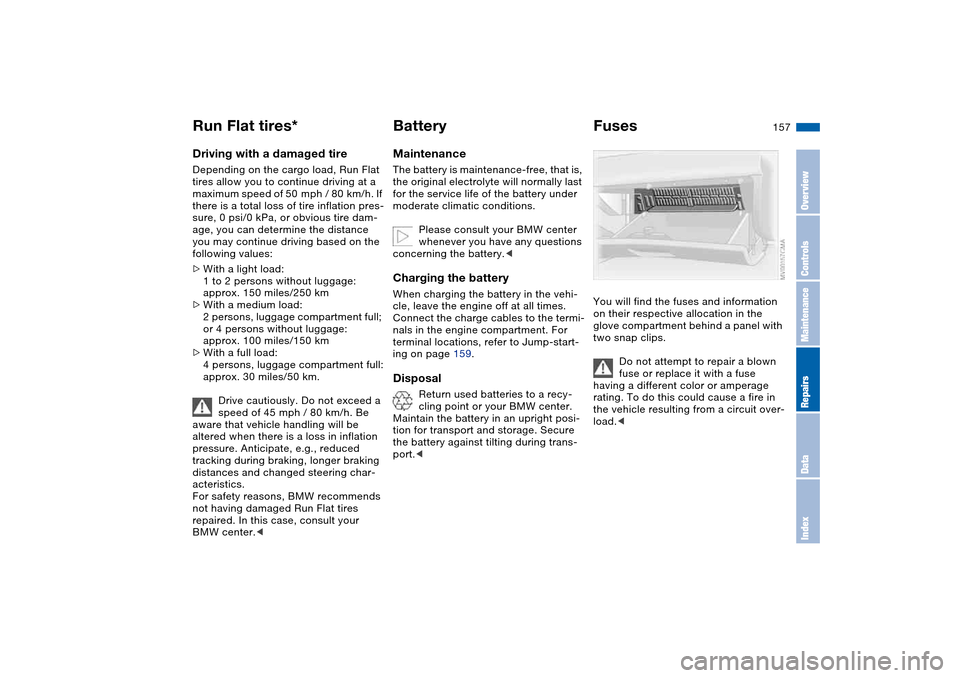Page 144 of 186
144
engine misfiring for even a short period
of time can seriously damage emission
control system components, especially
the catalytic converter.
SERVICE ENGINE SOON warn-
ing lamp for Canadian models.
If the gas cap is not on tight
enough, the OBD system can
detect leaking vapor and the indicator
will light up. If the gas cap is then tight-
ened, the indicator will usually go out
after a short period of time.
Page 157 of 186

157
Driving with a damaged tireDepending on the cargo load, Run Flat
tires allow you to continue driving at a
maximum speed of 50 mph / 80 km/h. If
there is a total loss of tire inflation pres-
sure, 0 psi/0 kPa, or obvious tire dam-
age, you can determine the distance
you may continue driving based on the
following values:
>With a light load:
1 to 2 persons without luggage:
approx. 150 miles/250 km
>With a medium load:
2 persons, luggage compartment full;
or 4 persons without luggage:
approx. 100 miles/150 km
>With a full load:
4 persons, luggage compartment full:
approx. 30 miles/50 km.
Drive cautiously. Do not exceed a
speed of 45 mph / 80 km/h. Be
aware that vehicle handling will be
altered when there is a loss in inflation
pressure. Anticipate, e.g., reduced
tracking during braking, longer braking
distances and changed steering char-
acteristics.
For safety reasons, BMW recommends
not having damaged Run Flat tires
repaired. In this case, consult your
BMW center.<
BatteryMaintenanceThe battery is maintenance-free, that is,
the original electrolyte will normally last
for the service life of the battery under
moderate climatic conditions.
Please consult your BMW center
whenever you have any questions
concerning the battery.
cle, leave the engine off at all times.
Connect the charge cables to the termi-
nals in the engine compartment. For
terminal locations, refer to Jump-start-
ing on page 159.Disposal
Return used batteries to a recy-
cling point or your BMW center.
Maintain the battery in an upright posi-
tion for transport and storage. Secure
the battery against tilting during trans-
port.<
FusesYou will find the fuses and information
on their respective allocation in the
glove compartment behind a panel with
two snap clips.
Do not attempt to repair a blown
fuse or replace it with a fuse
having a different color or amperage
rating. To do this could cause a fire in
the vehicle resulting from a circuit over-
load.<
Run Flat tires*
OverviewControlsMaintenanceRepairsDataIndex
Page 175 of 186

Everything from A to Z
175
Disposal
oil 139
vehicle battery 157
Distance warning, refer to
Park Distance Control
(PDC) 92
Door key 30
Door lock 33
Doors
emergency operation 33
Draft-free ventilation
105, 109
Driving light, refer to Parking
lamps/Low beams 97
Driving notes 125
Dry air, refer to Air condi-
tioning mode 104, 108
DSC Dynamic Stability Con-
trol 93
indicator lamp 19, 93
DTC Dynamic Traction Con-
trol 93
indicator lamp 19, 93
Dynamic Brake Control
(DBC) 19, 125
indicator lamp 19
Dynamic Stability Control
(DSC) 19, 93
Dynamic Traction Control
(DTC) 93
indicator lamp 19, 93E
Easy entry, refer to Entering
the rear 55
Electric power windows 40
Electrical accessories, fail-
ure 157
Electrical malfunction
automatic transmission
with Steptronic 81
door lock 33
driver's door 33
fuel filler door 24
luggage compartment
lid 35
Electronic Stability Program
(ESP), refer to Dynamic
Stability Control (DSC) 93
Emergency call 158
Emergency operation
closing the convertible
top 48
doors 33
driver's door 33
fuel filler door 24
Emergency release
luggage compartment lid
35, 36
Emissions, minimum, refer
to Energy control 86
Energy control 86Engine
breaking in 124
data 166
electronics 19
indicator lamp 19
speed 86, 166
starting 71
switching off 73
Engine compartment 136
Engine coolant 140
adding 140
Engine oil
adding 139
additives, refer to Adding
engine oil 139
capacity 169
consumption 138
indicator/warning lamp 19
quality 139
specified oils 139
viscosity 139
Engine oil level 19
check 138
indicator/warning lamp 18
Engine oil pressure
indicator/warning lamp 18
Engine oil types 139
Engine output, refer to
Engine data 166
Engine speed 86, 166
Entering the rear 55Environmentally-friendly
driving, refer to Energy
control 86
Equipment range, refer to
the Service and Warranty
Information Booklet for US
models / Warranty and
Service Guide Booklet for
Canadian models
ESP Electronic Stability Pro-
gram, refer to Dynamic
Stability Control (DSC) 93
Exterior mirrors 59
Eyelets, towing 161
F
False alarm, refer to
Avoiding unintentional
alarms 39
Fasten safety belts
warning lamp 18, 56
Fault displays 88
Filling the windshield washer
reservoir 169
First aid, refer to First-aid
kit 23
First-aid kit 23
Flashlight 111
Flashlight, refer to
Rechargeable
flashlight 111
OverviewControlsMaintenanceRepairsDataIndex
Page 185 of 186
Refueling
To ensure that you always have conve-
nient access to all essential information
when you stop for fuel, we recommend
that you fill out the adjoining chart by
entering the data that apply to your
vehicle. Consult the index for individual
specifications.
FuelPlease enter your preferred fuel here.Engine oilThe oil volume between the two marks
on the dipstick corresponds to approx.
1.1 US quarts/1 liter.Tire inflation pressureDesignation
Quality
Summer tires Winter tires
Front Rear Front Rear
Up to 2 persons
4 persons plus luggage